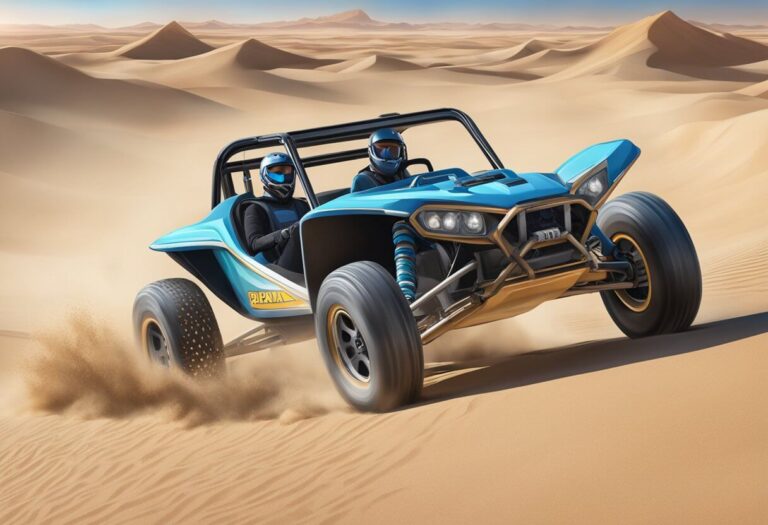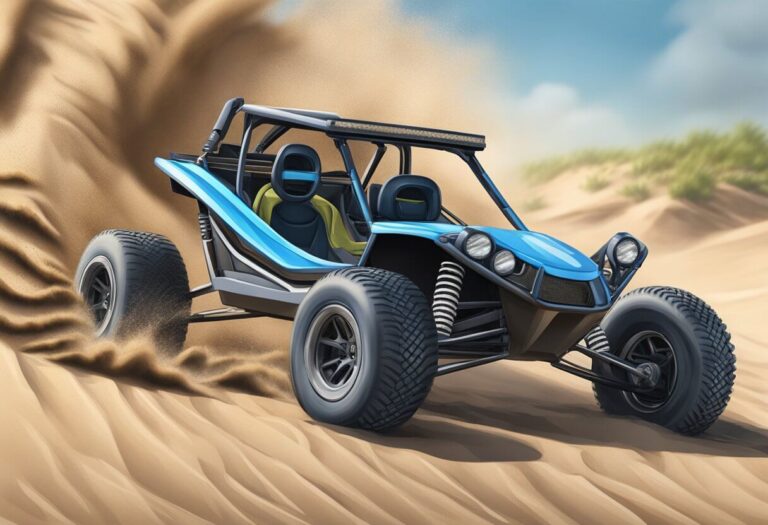Dune Buggy Tires: Choosing the Best for Off-Road Adventures

Dune buggies are off-road vehicles that are designed for driving on sand dunes, beaches, and other sandy terrains. These vehicles require specialized tires that can handle the unique demands of driving on sand. Dune buggy tires are wider than regular tires, and they have a lower air pressure to help them grip the sand better.
When it comes to buying dune buggy tires, there are many options available. One popular option is to purchase tires from online retailers like eBay and Amazon. These retailers offer a wide selection of tires at competitive prices, making it easy to find the perfect set of tires for your dune buggy.
Another option is to visit a specialized off-road center that specializes in dune buggy parts and accessories. These centers can provide expert advice on which tires are best suited for your specific needs and can help you find the right set of tires for your vehicle. Whether you’re a seasoned dune buggy enthusiast or a first-time driver, having the right set of tires is essential for a safe and enjoyable off-road experience.
Types of Dune Buggy Tires
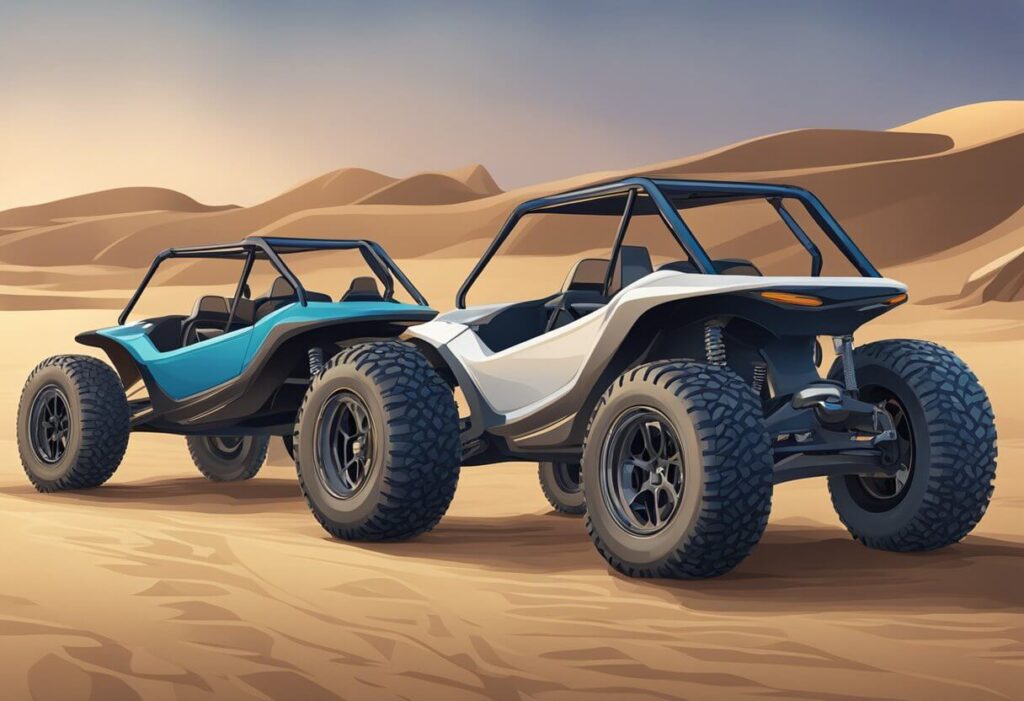
When it comes to dune buggy tires, there are several types available on the market. Each type of tire is designed for specific terrain and conditions. Here are the three main types of dune buggy tires:
Paddle Tires
Paddle tires are the most common type of dune buggy tire. They are designed for use on sand and provide excellent traction in sandy conditions. Paddle tires have large, scoop-like paddles that dig into the sand and propel the vehicle forward. They are typically wider than other types of dune buggy tires, which helps to distribute the weight of the vehicle over a larger surface area.
All-Terrain Tires
All-terrain tires are designed for use on a variety of surfaces, including sand, dirt, and pavement. They have a more traditional tire tread pattern than paddle tires, which allows them to grip the ground better on non-sandy surfaces. All-terrain tires are a good choice for dune buggy owners who want to use their vehicle for a variety of activities, including off-roading and street driving.
Mud Terrain Tires
Mud terrain tires are designed for use in muddy conditions. They have deep, wide grooves in the tread pattern that help to channel water and mud away from the tire. Mud terrain tires are not typically used on dune buggies, as they are designed for use on larger, heavier vehicles like trucks and SUVs. However, they may be a good choice for dune buggy owners who plan to use their vehicle in wet or muddy conditions.
So, choosing the right type of dune buggy tire is important for ensuring optimal performance and safety. Paddle tires are the most common type of dune buggy tire and are designed for use on sand. All-terrain tires are a good choice for dune buggy owners who want to use their vehicle for a variety of activities, including off-roading and street driving. Mud terrain tires are designed for use in muddy conditions and may be a good choice for dune buggy owners who plan to use their vehicle in wet or muddy conditions.
Size Considerations for Dune Buggy Tires
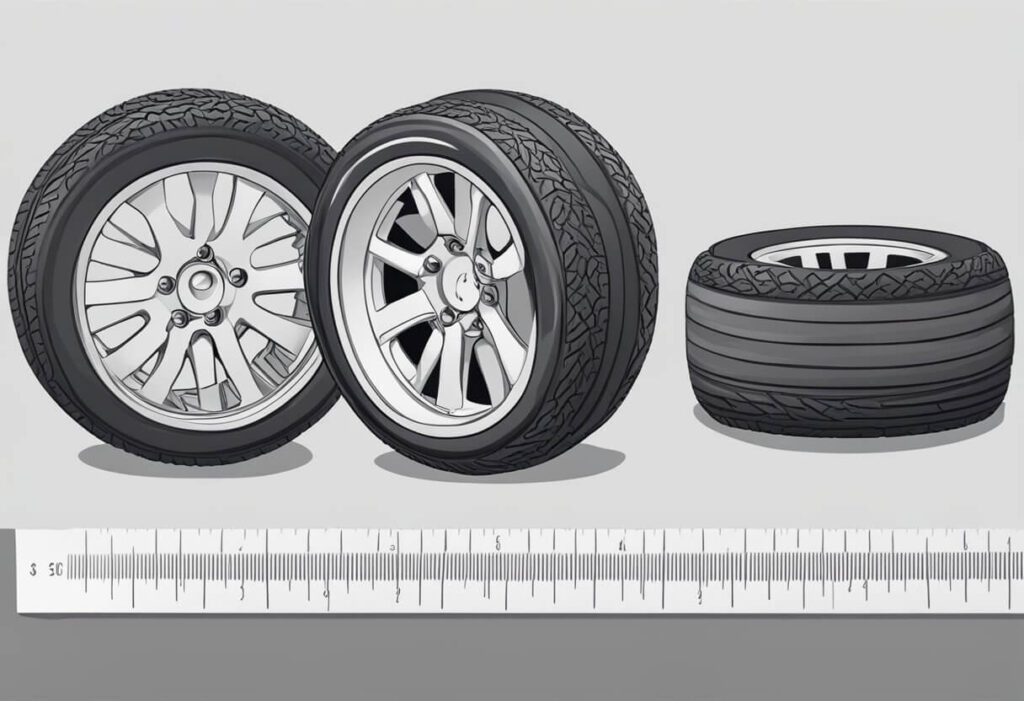
When it comes to dune buggy tires, size is an important consideration. The right size tires can improve the performance of your buggy, while the wrong size can negatively impact your ride. Here are some size considerations to keep in mind when selecting tires for your dune buggy.
Diameter and Width
The diameter and width of your dune buggy tires will affect its performance. Wider tires provide more traction and a smoother ride, while narrower tires are better for maneuverability. The diameter of the tire will also affect the gearing of your buggy. Larger diameter tires will result in a higher top speed, while smaller diameter tires will provide more torque.
According to a research, the width of the tire should be between 8.5-9.5 inches for 3.5-5 inches of tread pattern, 12-14 inches for 4.5-6 inches of tread pattern, 15-17 inches for 6-8 inches of tread pattern, and 18+ inches for 7.5+ inches of tread pattern. However, it is important to note that the optimal tire width will depend on the specific make and model of your dune buggy.
Aspect Ratio
The aspect ratio of your dune buggy tire is the ratio of the tire’s height to its width. A lower aspect ratio means a shorter sidewall and a wider tire, which can improve handling and cornering. A higher aspect ratio means a taller sidewall and a narrower tire, which can provide a more comfortable ride.
It is important to choose the right aspect ratio for your dune buggy based on your driving needs. If you plan to do a lot of off-roading, a lower aspect ratio may be the better choice. If you plan to use your dune buggy primarily for cruising, a higher aspect ratio may be more comfortable.
Overall, choosing the right size tires for your dune buggy is essential for optimal performance and safety. Be sure to consult with a professional or do thorough research before making your final decision.
Tire Tread Patterns

When it comes to dune buggy tires, one of the most important factors to consider is the tread pattern. The tread pattern of a tire determines its performance on different terrains and affects the ride quality of the dune buggy. There are three main types of tire tread patterns: directional, symmetrical, and asymmetrical.
Directional Treads
Directional treads are designed to provide maximum traction and handling on wet and slippery surfaces. These tires have a V-shaped pattern that allows water to flow away from the tire, preventing hydroplaning. They are also great for driving on snow and mud. However, directional tires are not recommended for dry surfaces as they can be noisy and wear out quickly.
Symmetrical Treads
Symmetrical treads have the same pattern on both sides of the tire and are designed for all-season use. These tires are great for driving on dry and wet surfaces, and they provide a smooth and comfortable ride. However, symmetrical tires are not recommended for extreme off-road use as they do not provide as much traction as directional or asymmetrical tires.
Asymmetrical Treads
Asymmetrical treads have different patterns on the inside and outside of the tire and are designed for high-performance driving. These tires provide excellent traction and handling on both wet and dry surfaces and are great for driving on winding roads. However, asymmetrical tires are not recommended for off-road use as they do not provide as much traction as directional or symmetrical tires.
In summary, the tread pattern of a dune buggy tire is an important factor to consider when choosing the right tire. Directional treads are great for wet and slippery surfaces, symmetrical treads are great for all-season use, and asymmetrical treads are great for high-performance driving.
Material and Construction
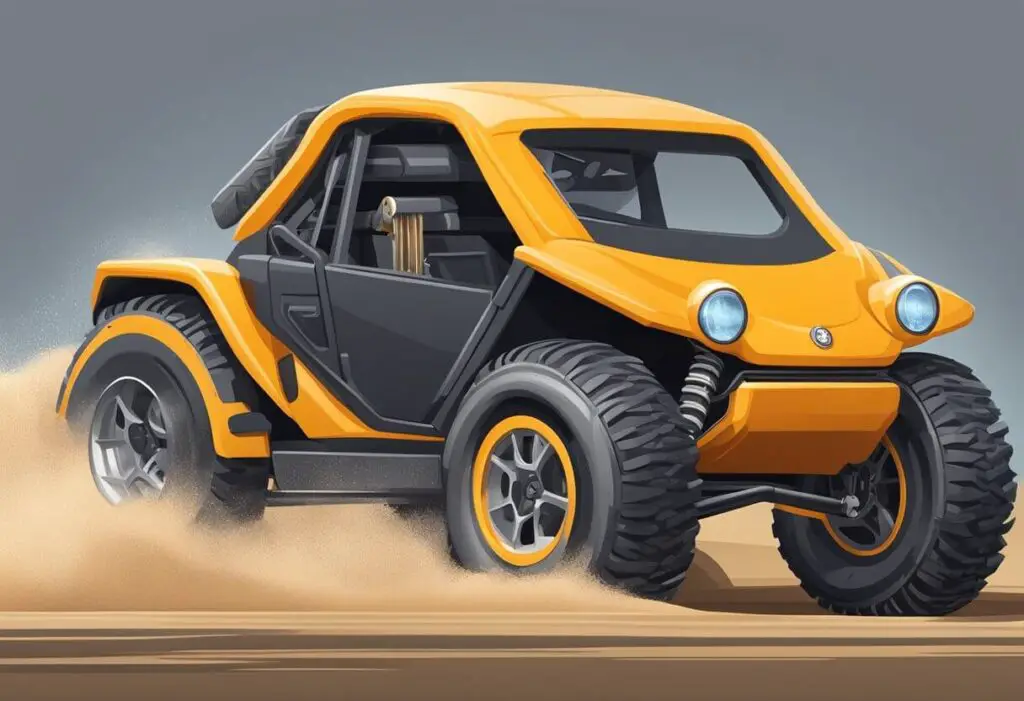
Rubber Compounds
One of the most important aspects of dune buggy tires is the rubber compound used in their construction. The right rubber compound can make a significant difference in the performance of the tires. Dune buggy tires are typically made of a softer rubber compound than regular tires. This allows them to grip the sand better and provide better traction.
Different rubber compounds are used for different types of terrain. For example, a softer rubber compound is used for sand dunes while a harder compound is used for rocky terrain. It is important to select the right rubber compound for the terrain you will be driving on to ensure maximum performance.
Bias Ply vs. Radial
Dune buggy tires can be either bias ply or radial. Bias ply tires are constructed with the cords running diagonally across the tire. This construction provides a stiffer sidewall, making it more resistant to punctures and cuts. Radial tires have cords that run perpendicular to the tire. This construction provides a more flexible sidewall, which allows the tire to conform to the terrain better.
Bias ply tires are better for rough terrain as they are more resistant to punctures and cuts. Radial tires are better for smoother terrain as they provide a smoother ride. It is important to select the right type of tire for the terrain you will be driving on to ensure maximum performance.
Tire Pressure and Performance

Proper tire pressure is essential for the performance of a dune buggy. The ideal tire pressure will vary depending on the terrain and the size of the tires. Incorrect tire pressure can lead to poor handling, reduced traction, and even tire damage.
Adjusting for Sand
When driving on sand, it is recommended to reduce tire pressure to increase traction. Lower tire pressure allows the tires to spread out and create a larger contact patch with the sand. This increases the surface area of the tire in contact with the sand, which in turn provides better traction.
According to the search results, it is important to keep the tire pressure between 8.5-9.5 inches for tire width and 3.5-5 inches for the size of the tread pattern. The tire pressure should be adjusted based on the size of the tire. For example, a tire with a height of 30 inches should have a tire pressure of around 10-12 psi.
Adjusting for Other Terrains
When driving on other terrains such as dirt or rocks, it is recommended to increase tire pressure to prevent tire damage and improve handling. Higher tire pressure reduces the surface area of the tire in contact with the ground, which decreases rolling resistance and improves handling.
It is important to note that the ideal tire pressure will vary depending on the size of the tire and the terrain. It is recommended to consult the manufacturer’s guidelines or seek advice from a professional to determine the ideal tire pressure for your specific dune buggy and the terrain you will be driving on.
Maintenance and Care
Regular Inspection
To ensure that your dune buggy tires are in good condition, it is essential to inspect them regularly. Inspect the tires before and after every ride, especially if you are planning a more extended excursion. Look for any signs of damage, such as punctures, cuts, or bulges. Check the tire pressure and ensure that it matches the manufacturer’s recommended pressure. If the tire pressure is too low or too high, it can cause uneven wear and tear, which can lead to reduced performance and decreased lifespan.
Proper Storage
Proper storage is crucial to maintain the performance and longevity of your dune buggy tires. When not in use, store the tires in a cool, dry, and clean place. Avoid storing them in direct sunlight or near heat sources, as this can cause the rubber to deteriorate. If you have to store them outdoors, cover them with a tarp or a tire cover to protect them from the elements. Before storing, clean the tires thoroughly and remove any dirt or debris. It is also recommended to rotate the tires periodically to prevent flat spots from forming.
When it comes to maintaining and caring for your dune buggy tires, a little effort goes a long way. Regular inspection and proper storage can help ensure that your tires perform optimally and last longer.
Upgrading Dune Buggy Tires
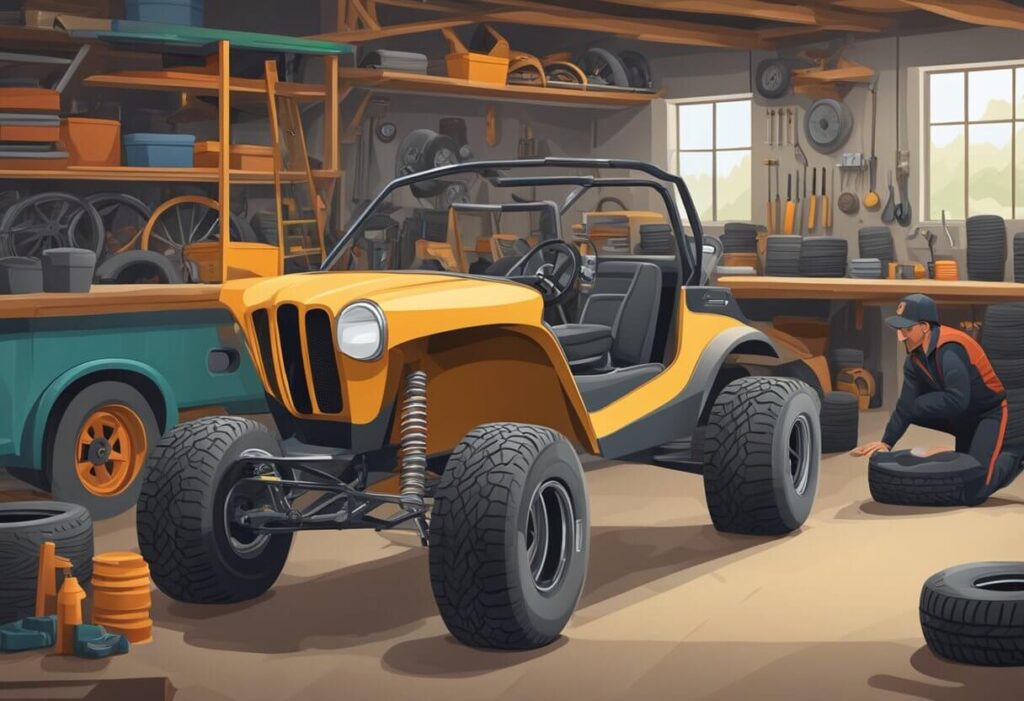
Performance Enhancements
Upgrading the tires on a dune buggy can greatly enhance its performance on sand dunes and rough terrain. One of the most important factors to consider when upgrading tires is the type of tire tread. Tires with deeper and wider treads provide better traction and stability on sand dunes. The Interco Interforce II All-Terrain Tire is a popular choice for dune buggies as it provides excellent traction and handling on desert dunes.
Another factor to consider is the tire pressure. The optimal tire pressure for a dune buggy varies based on the tire size and vehicle weight. It is important to consult the tire manufacturer’s recommendations to ensure the tire pressure is set correctly. Overinflated or underinflated tires can negatively impact the vehicle’s performance and safety.
Compatibility with Vehicle
When upgrading dune buggy tires, it is important to ensure compatibility with the vehicle. The tire size and width must be compatible with the vehicle’s suspension and wheelbase. The wider the tire, the more stable the vehicle will be on sand dunes. However, wider tires may not be compatible with all dune buggies. It is important to consult with a professional mechanic or tire specialist to ensure the selected tire is compatible with the vehicle.
Additionally, the tire height must be considered when upgrading dune buggy tires. Taller tires provide greater ground clearance, allowing the vehicle to navigate over larger obstacles on the track. However, taller tires may also impact the vehicle’s stability and handling. It is important to find a balance between tire height and stability to ensure optimal performance and safety.
Overall, upgrading dune buggy tires can greatly enhance the vehicle’s performance and safety on sand dunes and rough terrain. It is important to consider factors such as tire tread, tire pressure, tire size and width, and tire height when selecting new tires for a dune buggy. Consulting with a professional mechanic or tire specialist can ensure the selected tires are compatible with the vehicle and provide optimal performance and safety.
Safety Considerations
When it comes to dune buggy tires, safety should always be a top priority. The right tires can make a huge difference in the performance and safety of a dune buggy. Here are a few safety considerations to keep in mind when choosing and using dune buggy tires:
Tread Design
The tread design of a dune buggy tire is crucial for safe off-road driving. Tires with aggressive treads can provide better traction on loose surfaces, but they can also be more prone to slipping or hydroplaning on wet surfaces. On the other hand, tires with less aggressive treads can provide better handling on hard surfaces, but they may not perform as well on loose terrain.
Tire Pressure
Maintaining the correct tire pressure is essential for safe driving. Overinflated tires can reduce traction and increase the risk of a blowout, while underinflated tires can cause poor handling and increase the risk of a flat tire. It is important to check the tire pressure regularly and adjust it according to the manufacturer’s recommendations.
Load Capacity
It is important to choose tires with a load capacity that is suitable for the weight of the dune buggy and its passengers. Overloading a dune buggy can put excessive strain on the tires, which can lead to blowouts or other safety issues. Always check the load capacity of the tires before purchasing and using them.
Tire Maintenance
Proper tire maintenance is essential for safe driving. Regularly inspecting the tires for damage, such as cuts or punctures, can help prevent blowouts and other safety issues. It is also important to rotate the tires regularly to ensure even wear and prolong their lifespan.
By keeping these safety considerations in mind, dune buggy enthusiasts can enjoy a safe and thrilling off-road experience.
Legal and Environmental Concerns
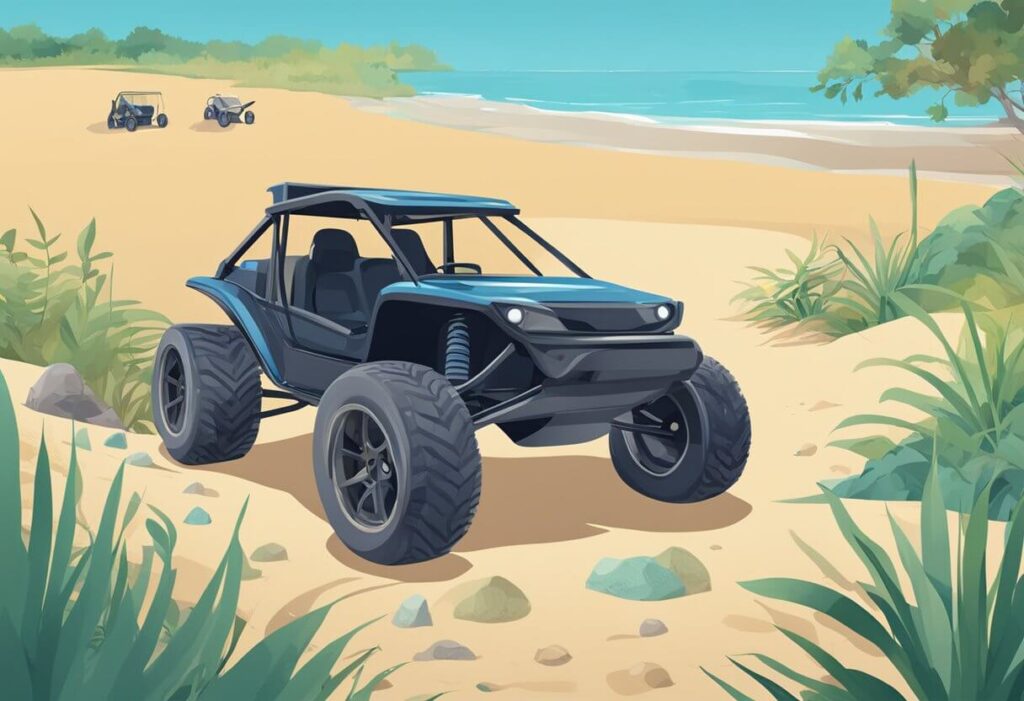
When it comes to dune buggy tires, there are a few legal and environmental concerns to keep in mind. Dune buggies are off-road vehicles, which means they are not typically street legal. However, it is possible to make a dune buggy street legal by meeting certain requirements set by the Department of Motor Vehicles (DMV). These requirements vary somewhat by state but generally include things like proper lighting, a windshield, seatbelts, and a certain level of emissions compliance.
It’s important to note that federal regulations for dune buggies are governed by the National Highway Traffic Safety Administration (NHTSA) and the Environmental Protection Agency (EPA). These agencies set standards for vehicle safety and emissions, and all vehicles, including dune buggies, must meet these standards to be considered street legal.
So, if you’re considering making your dune buggy street legal, be sure to research the specific requirements in your state and ensure that your vehicle meets the necessary safety and emissions standards.
In addition to legal concerns, there are also environmental concerns to consider when it comes to dune buggy tires. Off-road vehicles like dune buggies can cause damage to sensitive ecosystems and wildlife habitats. It’s important to always practice responsible off-roading and stay on designated trails to minimize the impact on the environment.
Additionally, choosing the right tires for your dune buggy can help reduce your impact on the environment. Look for tires that are designed for off-road use and have low rolling resistance to minimize your vehicle’s impact on the environment.

